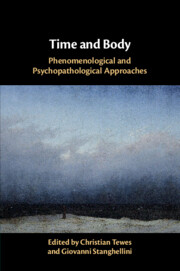Book contents
- Time and Body
- Endorsements for Time and Body
- Time and Body
- Copyright page
- Dedication
- Additional material
- Contents
- Figures
- Contributors
- 1 Introduction – Time and Body
- 2 Time, the Body, and the Other in Phenomenology and Psychopathology
- Part I Body and Time: General Aspects
- 3 The Body – Another
- 3.1 Commentary on “The Body – Another: Phenomenological and Psychoanalytic Perspectives”
- 4 The Heart of Darkness of the Living Body
- 4.1 Commentary on “The Heart of Darkness of the Living Body”
- 5 Microphenomenology of Chronicity in Psychosomatic Diseases
- 5.1 Commentary on “Microphenomenology of Chronicity in Psychosomatic Diseases: Diabetes, Anorexia, and Schizophrenia”
- 6 Time and Embodiment in the Process of Psychotherapy: A Dynamical Systems Perspective
- 6.1 Commentary on “Time and Embodiment in the Process of Psychotherapy: A Dynamical Systems Perspective”The Musicality of Human Interaction
- Part II Grief and Anxiety
- Part III Borderline Personality and Eating Disorders
- Part IV Depression, Schizophrenia, and Dementia
- Index
- References
6.1 - Commentary on “Time and Embodiment in the Process of Psychotherapy: A Dynamical Systems Perspective”The Musicality of Human Interaction
from Part I - Body and Time: General Aspects
Published online by Cambridge University Press: 30 October 2020
- Time and Body
- Endorsements for Time and Body
- Time and Body
- Copyright page
- Dedication
- Additional material
- Contents
- Figures
- Contributors
- 1 Introduction – Time and Body
- 2 Time, the Body, and the Other in Phenomenology and Psychopathology
- Part I Body and Time: General Aspects
- 3 The Body – Another
- 3.1 Commentary on “The Body – Another: Phenomenological and Psychoanalytic Perspectives”
- 4 The Heart of Darkness of the Living Body
- 4.1 Commentary on “The Heart of Darkness of the Living Body”
- 5 Microphenomenology of Chronicity in Psychosomatic Diseases
- 5.1 Commentary on “Microphenomenology of Chronicity in Psychosomatic Diseases: Diabetes, Anorexia, and Schizophrenia”
- 6 Time and Embodiment in the Process of Psychotherapy: A Dynamical Systems Perspective
- 6.1 Commentary on “Time and Embodiment in the Process of Psychotherapy: A Dynamical Systems Perspective”The Musicality of Human Interaction
- Part II Grief and Anxiety
- Part III Borderline Personality and Eating Disorders
- Part IV Depression, Schizophrenia, and Dementia
- Index
- References
Summary
Minkowski described the therapeutic relationship in terms of “two melodies being played simultaneously” (Minkowski, 1933/1970, p. 182). The final aim of therapy, in his view, was to establish a certain balance between these two melodies and grasp the patient's psyche. Accordingly, the therapeutic process should be conceived as a participatory experience , a dialogical, intercorporeal space (Fuchs, 2007) where the primary components are prereflective elements that converge into a participatory “we-subject.”
- Type
- Chapter
- Information
- Time and BodyPhenomenological and Psychopathological Approaches, pp. 117 - 122Publisher: Cambridge University PressPrint publication year: 2020



